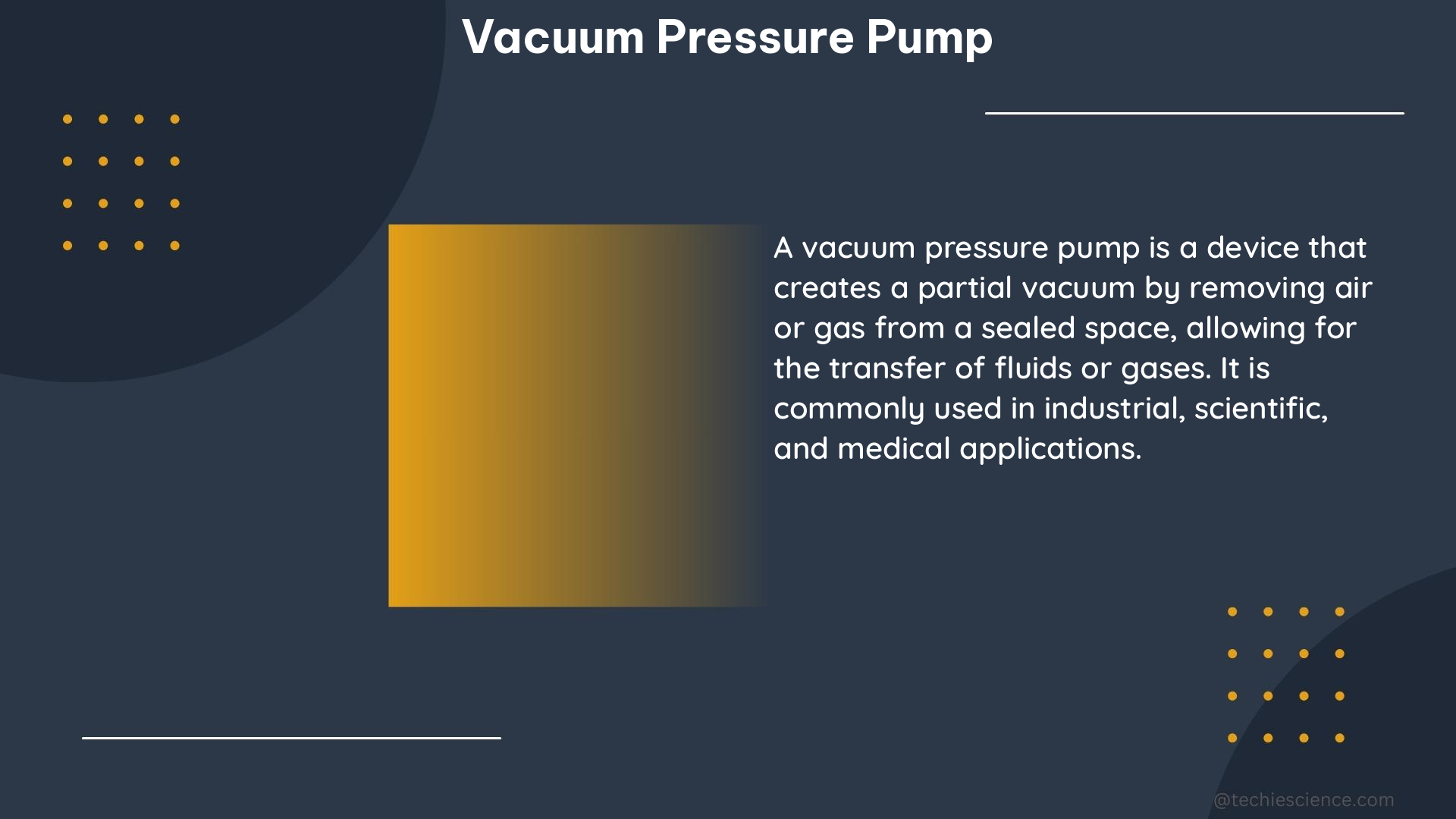A vacuum pressure pump is a versatile device used to create a partial vacuum by reducing the pressure of a gas in a given volume. These pumps are widely employed in various industrial and laboratory applications, such as vacuum-assisted coating, vacuum distillation, vacuum drying, and vacuum packaging. Understanding the technical specifications and performance characteristics of vacuum pressure pumps is crucial for selecting the right pump for your specific needs.
Pumping Speed (S)
The pumping speed (S) of a vacuum pressure pump is a crucial parameter that determines the volume of gas the pump can evacuate per unit time. This is typically measured in liters per second (L/s) or cubic feet per minute (CFM). A higher pumping speed indicates a more efficient pump, allowing for faster evacuation of the desired volume. For example, a rotary vane vacuum pump with a pumping speed of 50 L/s can evacuate 50 liters of gas per second.
Compression Ratio (CR)

The compression ratio (CR) of a vacuum pressure pump is the ratio of the inlet pressure to the outlet pressure of the pump, typically measured in a vacuum range. This parameter determines the pump’s ability to achieve a high level of vacuum. A higher compression ratio indicates a more powerful pump that can reach lower pressures. For instance, a rotary vane vacuum pump with a compression ratio of 100:1 can evacuate a chamber from atmospheric pressure (101.3 kPa) to a pressure of 1.013 kPa (10^-3 Pa).
Ultimate Vacuum (UV)
The ultimate vacuum (UV) is the lowest achievable pressure that a vacuum pressure pump can reach. This parameter is typically measured in pascal (Pa) or torr (1 torr = 133.322 Pa). A lower ultimate vacuum value indicates a more powerful pump that can create a higher level of vacuum. For example, a rotary vane vacuum pump with an ultimate vacuum of 10^-3 Pa can achieve a very high level of vacuum, suitable for applications such as thin-film deposition or high-precision scientific experiments.
Gas Ballast
The gas ballast feature of a vacuum pressure pump allows the pump to handle gases with high water vapor content. This is typically measured in liters per minute (L/min) or standard cubic centimeters per minute (sccm). The gas ballast introduces a controlled amount of air or an inert gas into the pump, preventing the condensation of water vapor and extending the pump’s lifespan. For instance, a rotary vane vacuum pump with a gas ballast of 5 L/min can effectively manage the evacuation of water-vapor-rich gases.
Power Consumption
The power consumption of a vacuum pressure pump is the amount of electrical power required to operate the device, typically measured in watts (W). This parameter is important for considering the energy efficiency and operating costs of the pump. A rotary vane vacuum pump with a power consumption of 1.5 kW, for example, would require a significant amount of electrical power to run, which should be factored into the overall operating costs.
Selecting the Right Vacuum Pressure Pump
When choosing a vacuum pressure pump, it’s essential to consider the specific requirements of your application, such as the desired vacuum level, the type of gas to be evacuated, the size and shape of the vacuum chamber, the available power supply, and the cost and maintenance requirements.
For a DIY vacuum pressure pump project, the design and construction process may involve the following steps:
- Selecting the Pumping Mechanism: Choose a suitable pumping mechanism, such as a piston, diaphragm, or rotary vane, based on your specific needs and the desired performance characteristics.
- Fabricating the Pump Housing: Design and fabricate the pump housing, ensuring it can withstand the required vacuum levels and accommodate the selected pumping mechanism.
- Constructing the Gas Inlet and Outlet Ports: Carefully design and integrate the gas inlet and outlet ports to optimize the pump’s performance and ensure efficient gas flow.
- Assembling the Pump Components: Assemble the various components of the vacuum pressure pump, such as the pumping mechanism, housing, and inlet/outlet ports, ensuring proper alignment and sealing.
- Testing and Calibrating: Thoroughly test the assembled pump and calibrate its performance to ensure it meets the desired specifications, such as pumping speed, compression ratio, ultimate vacuum, and gas ballast.
By understanding the technical specifications and performance characteristics of vacuum pressure pumps, you can make an informed decision when selecting or designing a pump for your specific application. Remember to consult the resources provided at the end of this article for additional information and guidance on vacuum pressure pumps.
Reference:
- Vacuum Fundamentals: Vacuum Measurement – Leybold USA
- How To Use the Q=SP Fundamental Vacuum Relationship – Caltech GPS
- How To Use the Q=SP Fundamental Vacuum Relationship – Normandale Community College

The lambdageeks.com Core SME Team is a group of experienced subject matter experts from diverse scientific and technical fields including Physics, Chemistry, Technology,Electronics & Electrical Engineering, Automotive, Mechanical Engineering. Our team collaborates to create high-quality, well-researched articles on a wide range of science and technology topics for the lambdageeks.com website.
All Our Senior SME are having more than 7 Years of experience in the respective fields . They are either Working Industry Professionals or assocaited With different Universities. Refer Our Authors Page to get to know About our Core SMEs.